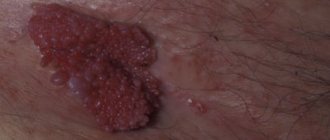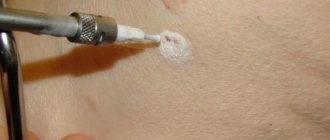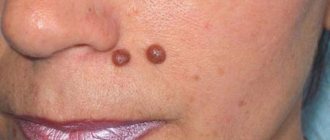Human papillomavirus (HPV) can be present in the body for many years without manifesting itself. During periods of stress, colds, exacerbation of chronic diseases and weakened immunity, viruses “come out” in the form of skin tumors. Most often, papillomas appear under the armpits - moisture and sweat secretions constantly accumulate in this area of the body, which are a favorable environment for the spread of microorganisms.
Causes of warts under the arms
It is an established and confirmed medical fact that the appearance of warts of any kind is associated with human infection with the papilloma virus, which can remain in the body for a long time in a latent, inactive state. In this case, the carrier does not even suspect the presence of a viral agent in the blood. Infection can occur in several ways:
- Personal contact with a carrier of the papilloma virus;
- Household way - using common personal items: towel, comb, etc.;
- Autoinaculation – self-infection (damage to healthy areas of the epidermis by a virus);
- Penetration of HPV into the body through microcracks and cuts during shaving or epilation of the armpits;
- Transmission of the viral carrier from mother to child through the placenta.
It should, however, be understood that in order to activate the life of the virus, it is necessary to create accompanying conditions. The most important factor provoking the appearance of hanging warts under the arms is a sharp decrease in immunity, which can be associated with vitamin deficiency, poor nutrition, stress and overwork. In addition, the formation of warts under the arms is most often observed during periods of severe inflammatory and infectious processes or against the background of hormonal imbalance.
Who is at risk
This disease primarily affects people with weakened immune systems and chronic diseases (for example, diabetes). Also, the group of people who can potentially become infected with HPV include:
- patients ;
- pregnant and nursing mothers;
- people who abuse alcohol , smoking, and drugs;
- elderly people ;
- people exposed to sunlight for a long time;
- patients who have had infectious diseases;
- women who do not use contraception during oral sex;
- people who do not observe basic rules of personal hygiene.
Are hanging warts dangerous?
Hanging warts may not pose a significant danger to the patient's body until the onset of certain factors and conditions that can lead to the growth of the tumor and its spread to surrounding healthy tissue. In this case, multiple warts are noted, which brings not only aesthetic discomfort, but is also fraught with the development of an oncological process.
Another hidden threat of warts under the arm is the high probability of trauma and mechanical damage to the growth during shaving. In this case, severe bleeding may occur, which is caused by a violation of the integrity of the dense capillary and vascular network that nourishes the body of the wart. In addition, there is a high risk of infection through an open wound surface. In rare cases, uncontrolled atypical division of epidermal cells can lead to the development of a malignant tumor.
Factors leading to the manifestation of HPV
A neoplasm may appear during a period when one or more provoking factors act on the body:
- changes in hormonal levels (during pregnancy, menopause, endocrine diseases, taking contraceptive hormonal drugs);
- stress, difficult working conditions, hypothermia are factors leading to a weakening of the body’s immune defense;
- intoxication, which can be caused by regular drinking of alcohol, smoking, taking drugs, working in hazardous industries, food poisoning;
- periods of exacerbation of chronic diseases of the digestive, urinary, cardiovascular systems of the body.
Removal of papillomas under the arms is often required not only to eliminate an aesthetic defect, but also to eliminate the risks of complications. The most dangerous complication is the likelihood of benign growths degenerating into malignant tumors, which can lead to cancer.
HPV in the armpits: main symptoms
Neoplasms under the arms have the following characteristic features:
- Diameter from 1 to 10 mm. The size of the growths is determined by the condition of the body and the type of virus (about 130 different types of HPV are known).
- The growths under the armpits do not cause pain, they do not itch or itch. They can be identified visually or tactilely - when you run your hand over the skin, you can feel the rough processes.
- The hue of the growths most often matches the color of the surrounding skin, but can stand out as a much darker color.
Why is it important to see a doctor on time?
Despite the absence of pain, the neoplasm can cause significant discomfort, making hygienic hair removal procedures difficult. When shaving, you can very easily damage the growth, which provokes an inflammatory process. The growths may increase in size and spread to other areas - to the shoulders, arms, neck. The inflammatory process is often accompanied by pain, itching and bleeding.
When you contact the clinic, the doctor will conduct a diagnosis, prescribe the necessary tests and select the appropriate method of therapy. Attempts to get rid of growths using alcohol solutions or folk remedies can lead to the opposite effect and provoke an increase in the inflammatory process.
Hanging warts: treatment
The treatment of warts under the arms must be entrusted to a professional doctor, since self-removal or taking medications may not only not give the expected result, but also significantly harm the patient. The treatment procedure for hanging warts usually involves three stages:
- Removal of the body and root of the tumor: laser destruction, radio wave excision, electrocoagulation, cryodestruction or surgical removal;
- Antiviral therapy;
- Restoration of immune function – immunomodulation or stimulation;
- The most important step in the treatment of warts under the arms is the procedure for removing the skin growth. Today, the optimal way to get rid of a tumor in the armpit is laser correction of the defect .
You can find out more about the service and its cost here >>
Diagnostics
If a papilloma is accidentally injured, it is necessary to treat the painful area with disinfectants to avoid infection. Until the wound heals, it is better not to use antiperspirants, exclude items with narrow sleeves from your wardrobe and follow all the rules of personal hygiene.
Why can our articles be trusted?
We make health information clear, accessible and relevant.
- All articles are checked by practicing doctors.
- We take scientific literature and the latest research as a basis.
- We publish detailed articles that answer all questions.
If a person discovers papilloma under his arms, first of all, he needs to be examined by a dermatologist. Using palpation, he will determine the structure of the papilloma and its size. After this, he may send for additional research:
- PCR diagnostics, in which it is possible to identify the risk that papilloma may degenerate into malignant;
- taking a biopsy from the papilloma for histology. Based on its results, it is also possible to determine what form this formation is;
- It is mandatory to donate blood to determine the HPV type.
After receiving the results of a comprehensive examination, the doctor prescribes treatment or surgery. If the benign nature of the formation is confirmed, the doctor will simply monitor it over time, otherwise an operation to remove the wart will be prescribed.
Advantages of laser destruction over other methods of wart removal:
- Simplicity of the procedure. The manipulation takes only a few minutes, without requiring a long preparatory and postoperative period;
- Safety. The laser beam penetrates pathological tissues without damaging the healthy epidermis;
- Painless. Laser removal of skin defects does not cause discomfort to patients, due to the permissibility of using local anesthetic gels and solutions;
- Efficiency. During the process of removing a tumor, a specialist has the ability to regulate the depth of exposure, which determines the complete excision of atypical cells, without the formation of rough scars and cicatrices.
Contacting a medical professional will be the main step towards getting rid of warts. We guarantee affordable prices, high-quality medical service and the use of high-tech laser equipment.
Find out the cost of the procedure “Removal of tumors”
Types of warts and their location
1. Simple or vulgar warts occur mainly in children and adolescents. These are round, dense growths on the hands, face or lips. More than 65% of all skin warts are of this type. 2. Flat warts of various shapes with a smooth surface appear in adolescence on the fingers, feet, and oral mucosa and are not common - only 3-4% of all cases. 3. Palmoplantar papillomas can appear at any age. These are hard, round formations with layers of keratinized layers of skin. Most often they form on the feet and over time cause a person severe pain when walking. 4. Thread-like papillomas of flesh-colored, brown or coffee color are located in the folds of the skin of different parts of the body - genitals, armpits, eyelids, neck. These are elongated warts with a “pedicle”. 5. Soft genital warts are located on the mucous membranes in the groin, rectum or urethra. They manifest themselves in the form of a ball, pyramid or nodular cluster, and are rarely found in a single copy. Genital warts are often multiple growths with a keratinized surface.
Human papillomavirus is the cause of warts, condylomas and papillomas
Human papillomavirus is a family of viruses that cause warts, papillomas, condylomas, dysplasia or cancer of the cervix and genital organs in humans. General family: Papillomaviridae . Latin name: Human Papillomavirus . Abbreviation: HPV or HPV (as written in tests). 1. Over 50 years, more than 100 types of human papillomavirus have been discovered. Pathogenic for humans - 80 types. 2. According to WHO, 70% of the world's population is infected with HPV. 3. HPV types 16 and 18 are more likely than other types to lead to cervical cancer. 4. HPV is the overwhelming cause of genital cancer in women and men. 5. The most effective prevention against cervical and genital cancer throughout the world is considered to be a vaccine against types 6, 11, 16 and 18 of papillomaviruses. Infection.
The source of the virus is the skin cell or mucous membrane of a sick person. If a patient has a papilloma, even a small one, it is the direct source of the virus! However, upon examination, the patient may not yet have a wart or condyloma. The changes may still be microscopic and not visible to the eye (subclinical stage of the disease). But such a person can already transmit the virus to another person. Infection usually occurs in childhood. Through microdamage to the child's skin (scratches, abrasions), the papillomavirus penetrates the skin and causes the appearance of warts. In adults, certain types of the virus (discussed below) cause the development of anogenital warts, or genital warts, on the genitals. The transmission mechanism of these types is predominantly sexual. But contact-household transmission is also theoretically possible - through general hygiene items, the toilet rim, taking a bath, visiting a bathhouse, swimming pool, etc. Through microtraumas of the genital organs, the virus is transmitted from one sexual partner to another. In this case, the patient may also not have any changes visible to the eye. But there may be microscopic changes in the mucous membrane of the genital organs. And these altered cells are the sources of the virus. Next, the virus penetrates the skin or mucous membrane and is met by various cells of the human immune system. In most cases, immune cells destroy the virus. But if the immune system is weakened, the virus manages to penetrate the cells of the basal layer of the epithelium of the skin or mucous membranes, integrates into the chromosomes of the cells and changes the functioning of these cells. The cells begin to divide excessively and grow in a limited area, externally turning into warts and papillomas. Remember: - HPV types that cause warts enter the body during childhood, - HPV types that cause genital warts enter the body primarily through sexual contact. In rare cases, the development of human papillomavirus infection in the human body can lead to malignancy (that is, degeneration into cancer). Therefore, all types of papillomaviruses are classified according to the degree of oncogenicity (that is, according to the degree of possible cancer development). Classification of HPV types by oncogenicity (according to studies by McConcl DJ, 1991; Lorincz A. T., 1992; Bosch E X. et al., 2002; Kozlova V. I., Puchner A. F., 2003; Syrjanen S., 2003; Shakhova N.M. et al., 2006;). 1) Types of papillomaviruses that never cause cancer: 1, 2, 3, 4, 5, 10, 28, 49 2) Types of low oncogenic risk (very rarely cause cancer): 6, 11, 13, 32, 34, 40, 41, 42, 43, 44, 51, 72. 3) Types of average oncogenic risk (average percentage of cancer degeneration): 26, 30, 35, 52, 53, 56, 58, 65. 4) Types of high oncogenic risk (of all types of the virus, these are the types that most often give rise to degeneration): 16, 18, 31, 33, 39, 45, 50, 59, 61, 62, 64, 68, 70, 73. This is especially important in women. By the way, sometimes the classification changes. For example, HPV type 58 in women is no longer highly oncogenic. It began to be classified as a type with average oncogenicity. Occurrence in diseases: • In 73-90% of cases with cervical cancer they find: 16, 18 and 45 types of HPV • In 77-93% of cases with cervical cancer they find: 16, 18, 45, 31 and 59 types of HPV • B In 80-94% of cases of cervical cancer, the following are found: HPV types 16, 18, 45, 31, 33 and 59 • Precancerous conditions in urology and gynecology are often combined with HPV types 61, 62, 68, 70, 73. The most common types found in tests are: • human papillomavirus 16 (written HPV 16) - 50% • human papillomavirus 18 (HPV 18) - 10% Symptoms and clinic Symptoms and manifestations of HPV infection are warts, papillomas and cervical dysplasia. A) Warts. They are caused by the following types of HPV - 1, 2, 3, 4, 5, 10, 28, 49. • juvenile (or flat) warts - caused by types 3 and 5 of the virus. These are small flat elevations on the skin that occur mainly in children. • spinules (or plantar warts) - caused by types 1 and 2 of the virus (you can read more about them. • vulgar warts on the fingers - caused by type 2 viruses.
These are flat warts on the face
These are vulgar warts on the hand
B) Genital warts. Localization : on the genitals, in the anus, in the oral cavity and on the lips (types - 6, 11, 13, 16, 18, 31, 35).
These are genital warts
The main mechanism of transmission of this disease in adults is sexual. Very rarely, a contact route of transmission can occur - through shared toilet items, through a dirty toilet rim, using a shared bathroom, in a bathhouse, etc. If a mother suffering from genital condylomatosis gives birth to a child, he will also become infected and subsequently may also develop genital warts or papillomatosis of the larynx and respiratory tract (discussed above). However, the frequency of such symptoms in infants is extremely low. Children have a fairly high level of immunity, which protects them from such manifestations of infection. B) Laryngeal papillomatosis. Multiple papillomas appear on the vocal cords. Caused by virus type 11. Sometimes it appears in children born to women with genital warts.
This is laryngeal papillomatosis
Remember: - cervical erosion and HPV are FAR from the same thing. A detailed article about what cervical erosion is and how it differs from dysplasia and HPV is here. Modern medicine declares with 100% certainty that cervical cancer is caused exclusively by papillomavirus types 16, 18, 31, 33, 35, 39, 40, 42, 43, 55, 57, 59, 61, 62, 66, 67. In the diagram - development of HPV infection over the years
E) Skin cancer of the penis (Bowen's disease). Caused by virus types 16 and 18. G) Today, some foreign scientists believe that the human papillomavirus is the cause of cancer of any location. Since cancer is a malignant tumor of the epithelium of the skin or mucous membrane, therefore, the HPV virus, which causes dysplastic phenomena in the epithelium, causes the appearance of cancer. And with cervical cancer this has been proven 100%. There is evidence for breast cancer and laryngeal cancer, although it has not yet been formalized into global recommendations. And, according to some cancer researchers, the day is not far off when cancer of other locations (for example, intestines) is also recognized as the result of the activity of the human papillomavirus in the human body. Remember: - any viral infection that is constantly present in the human body (and HPV is one of these) is activated only when immunity decreases. Diagnostics 1) PCR analysis. The main method for diagnosing papillomavirus is the PCR reaction. The most common types of HPV tests are virus types 16, 18, as well as a number of other highly oncogenic types. Material for analysis is taken from the mucous membrane of the woman’s vagina and cervix. In men - with the mucous membrane of the penis. The PCR reaction can also give a false result, both a false positive and a false negative result, especially if the conditions for its implementation are violated (even a push of the table on which the study is being carried out can lead to such a false result). Thus, according to modern researchers in the West, up to 20% of all PCR results for papillomavirus were false. And this fact did not depend on the complexity of the equipment and the quality of the reagents. 2) Digene test. New research gaining popularity in the medical community. This test is used to determine the presence of clinically significant concentrations of the virus. Thanks to this test, it is possible to identify whether the viruses in the patient’s body have a high or low degree of oncogenicity. The Digene test is used in conjunction with a cytological examination of the cervix, and they are also evaluated comprehensively. 3) Examination by a gynecologist and/or urologist. 4) Cytological examination. A smear taken during a gynecological examination is examined. This study is often called “liquid-based cytology”, or simply “cytology”. In this case, a laboratory doctor, under a microscope, determines the presence or absence of pathologically altered cells, which should not normally be present, but they appear only with the development of the disease. The presence of such altered cells may indicate the presence of CIN (or cervical dysplasia) in a woman. 5) Histological examination. A microscopic piece of tissue is examined, also taken during a gynecological or urological examination. Another name for this test is “biopsy.” Under a microscope, the doctor evaluates the degree of change in the tissue taken for examination.
How to interpret an HPV test?
The unit of measurement is the number of genome equivalents (in simple terms, the number of viruses) per 100,000 human epithelial cells (that is, by 10 to the 5th power). Abbreviated form: Lg Gradations: 1. < 3 Lg, that is, the number of viruses is less than 3 per 10 to the 5th power. This is a good indicator, the viral load is small, that is, the concentration of the virus is insignificant, the risk of developing the disease is low. 2. 3 – 5 Lg. This is a clinically significant indicator. The risk of developing the disease is average. It is necessary to undergo examination by a doctor. 3. > 5 Lg. High viral load. You should definitely undergo a full examination to exclude cervical dysplasia. What is a reference value? This means the average statistical indicators for a given study in a given age group. That is, in simple terms, reference values are the norm. For HPV, the reference values are negative. That is, normally there should not be HPV in the tests. What is KVM? KVM is the control of material taking. Normally, the doctor should take a scraping so that the sample of material contains at least 10,000 (or 10 to the power of 4, or 4Lg) epithelial cells. If the CME value is less than 4Lg, this means there are few cells for analysis. The analysis is not recommended, as it will be uninformative, and the doctor is recommended to repeat the collection of material. Treatment When treating human papillomavirus, you need to know: the virus may not be completely removed from the body. The main goal of treatment is to increase immunity, stabilize the virus, remove manifestations of the virus and reduce its concentration in the body so that the human immune system itself suppresses the virus. 3 areas of treatment are required (carried out by a specialized infectious disease specialist, immunologist, dermatologist or gynecologist): • taking antiviral drugs • strengthening the immune system • removing manifestations - warts, condylomas, dysplasia (erosion) or cervical cancer. All 3 areas are effectively carried out by modern medicine. Self-medication has low effectiveness and can lead to progression. Self-medication for diseases of the genital area is especially dangerous. 1) Antiviral drugs • Isoprinosine (or groprinosin), Allokin-alpha, • 5% Aldara cream. The active ingredient is imiquimod. 2) Drugs that enhance immunity Polyoxidonium, Reaferon, Roncoleukin, Immunal and others. The main drug for advanced forms at the moment is roncoleukin, which is used according to a certain scheme (prescribed by an immunologist or infectious disease specialist) 3) Removal of papillomas, warts, condylomas can be - Scalpel - classical surgery, electrocoagulation or an electric loop knife, radio wave removal, liquid nitrogen. These are outdated techniques that are traumatic, not always effective and can lead to relapses and post-burn scars at the sites of removal. -Laser - today this is the best method in terms of efficiency, safety, aesthetics. It is not recommended to use locally necrotizing drugs (acids, alkalis): Superchistotel, Solcoderm, Duofilm, Collomak, Verrukatsid, Ferezol, Condilin - and a number of others, since their application to the skin can contribute to the spread of the virus to healthy, previously uninvited areas of the skin, and also leads to skin burns and subsequent scarring
Required: a healthy lifestyle that improves immunity. Remember: First the doctor must make the correct diagnosis, and this is already half the treatment!!! Including treatment of human papillomavirus. Therefore, in the presence of multiple warts or relapses, it is recommended to first conduct a course of antiviral and immunomodulatory therapy under the supervision of an infectious disease specialist or immunologist!
Prevention of HPV Prevention is the best cure. Remember this phrase, especially when it comes to the sexual sphere. Nature has come up with a wonderful healing and prevention mechanism for humans, which then helps him not to get sick again. This is the immune system. If a person has already had warts or papillomas once, then he subsequently develops immunity to this type of virus. Therefore, juvenile warts, spinules and warts vulgaris very rarely appear in adults. This is why it is SO IMPORTANT to maintain your immunity at a high level. Let us list the main directions for the prevention of papillomavirus infection in humans: • Personal hygiene measures in public places • A healthy lifestyle that maintains immunity at a high level • Correct work and rest regime • Moderate physical training • Taking vitamins, fruits, juices • Only one sexual partner (in ideally) • Using a condom during sexual intercourse
We bring to your attention 3 videos on the removal of papillomas and warts at the Aurora clinic!!!
Find out more about the service and cost of tumor removal










